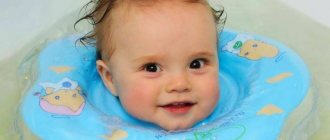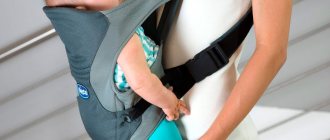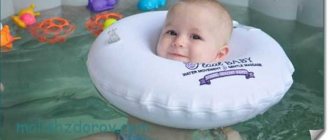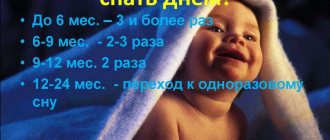Updated: 06/30/2021 12:09:53
In the modern world, a circle for bathing babies is increasingly gaining popularity among young parents. It makes the bathing process easier and more fun for both children and adults. If you follow the recommendations of experts, you can get unforgettable emotions.
At what age can you bathe a child with a ring on his neck?
There is no consensus on the question of at what age you can bathe a baby with a circle on his neck. Pediatricians say that such procedures are prohibited until the umbilical wound heals, in order to prevent it from becoming infected. In addition, in the first month the child undergoes an adaptation process to new conditions. It is generally accepted that bathing with a circle is allowed no earlier than 2 months, although many young mothers begin bathing their baby with a circle as early as 1.5 months.
But kinesiotherapist Maria Nadtochey, a specialist in neurological massage, and Alina Suvorova, an early swimming instructor, are of the opinion
that the best age for swimming with a circle around the neck is from 2.5 to 3 months. The baby's adaptation period has already ended. In addition, in the first 2 months of life, the baby does not hold his head well, the neck muscles are still in a relaxed state. At this age there is a risk of injury to the cervical spine. When a newborn is lying on his stomach in a circle, he experiences prolonged and severe hyperextension of the cervical spine, which is still very fragile. It turns out that the child’s body seems to be “dangling” from the neck. If he had a neck injury during childbirth, then the circle will only worsen the condition.
In children under 3 months of age, the innate swimming reflex is still preserved. Subsequently it decreases. After all, their origin and development occurs precisely in the aquatic environment. They reflexively hold their breath under water and stay on the surface well. After 3 months, when the swimming reflex decreases, the child will begin to perceive water as a hostile environment. Therefore, the age from 2.5 to 3 months is considered ideal in this regard.
As a rule, parents practice swimming with a circle until their children are 2 years old. If the baby likes this process, then swimming with a circle can be done up to 3 years. In this case, you will have to look for a model that matches this age.
Neck circle for swimming - how to use it correctly
Inflatable ring
is a safe, easy-to-use and affordable product that can free up time for your business. However, many mothers are not yet very confident in such a device. They believe that safe bathing for the baby is only possible if you hold the baby with your hands.
Bathing circle design
Swimming circle
- This is a special chamber filled with air. Usually inside such a circle there is another pocket that does not come into contact with the outer shell. Operation of the inflatable ring is possible only after filling both chambers with air. The circle is fixed with Velcro or connectors that are resistant to moisture. They will not unfasten under water, which guarantees the baby a comfortable swim without any problems or injuries. The circle has an interesting design aimed at children - there are different images, colorful drawings, and colorful patterns that will delight the baby and influence his love of swimming. Often the circle is also supplemented with toys - various balls, rattles, musical triggers that allow you to play a melody. The baby will definitely not get bored!
Is there any benefit to using a circle? What do doctors say about this?
Pediatricians' advice recommends using an inflatable ring, but under close supervision of the baby. The product is very functional and useful, it carries a lot of advantages for both parents and the baby.
The main advantages of using a circle during water procedures:
- The back muscles become stronger;
- The physical development of the baby is complex;
- Metabolic processes improve, the child adapts better to the environment and ceases to be afraid of water;
- Intrathoracic pressure stabilizes;
- The baby's lungs are strengthened;
- The baby’s immunity increases, he stops getting sick often;
- Colic, constipation and other problems will disappear;
- The baby relaxes, stops being capricious, and he associates bathing with pleasant emotions.
Water procedures help calm the child. Pediatricians say that circle exercises are best done in the evening, since such therapy allows you to achieve sound sleep. A child who exercises with a circle for about 10-20 minutes is characterized by good development. He learns to walk faster, acquires all the necessary skills and gets acquainted with the world around him.
How to safely put a ring on a newborn
Before using an inflatable ring to bathe a newborn, you need to check if there are any holes in it that could allow air to escape. It is also worth washing it in soapy water and then drying it thoroughly. The circle should fit snugly around the child's neck. The baby must always stay afloat. Many products have special handles that allow you to guide or move your child. The circle makes it possible to move from the back to the stomach and back - this will not cause any discomfort to the baby.
How does the first dive with a circle work?
First, you need to carefully place the circle around the baby’s neck. At the same time, you need to try to talk to the child so that he does not experience fear or discomfort. The immersion is carried out gradually, without sudden movements. Let the baby first get used to the new procedures. High-quality bathing circles have recesses for the baby’s chin, which improves bathing efficiency and helps the baby get used to the water as quickly as possible. If there are external seams inside the small circle, it is best to refuse to purchase this product - this is a low-quality fake.
Suitable age for using inflatable rings
The inflatable ring can be used almost from the very birth of the baby. At least that's what the product manufacturers say. In practice, it is better to postpone the start of bathing a child with a circle until the baby’s navel has healed, otherwise your child will be capricious. The best age to start water procedures with a circle is approximately 1 - 1.5 months. The accessory is used until the child reaches 2 years of age. Even if the child cannot yet hold his head up on his own, this does not mean that the circle is not applicable - the product does not put any stress on the baby’s neck, so it will definitely not cause harm.
Optimal swimming time
For the first time, it is better not to give your baby long swims - just limit it to 10 minutes. Let the baby get used to the new accessory. This will avoid unnecessary stress and anxiety. Subsequently, it will be possible to increase the time of bathing with a circle to 15-20 minutes. Using a circle is a good way to train your baby’s muscles and improve his physical condition. The child develops faster and outperforms his peers. Do not be afraid of using this accessory, because it allows parents to free their hands and have free time to perform any household tasks.
Choose the right circle for swimming!
How to choose a circle for your neck
The neck ring for bathing a baby consists of two separate swimming rings - inflatable chambers. They are connected to each other with Velcro. Children usually love this accessory. With its help, the baby calmly immerses himself in an adult bathtub, swims in it, and moves his arms and legs.
It is best to go shopping for a circle with your child and make a preliminary selection. Many young parents have a completely understandable question about what to look for when purchasing a product. First of all, make sure that the accessory does not emit a specific pungent odor and that its seams are strong and safe. Pay attention to whether there are any visible holes in the circle. Although, there are small holes invisible to the eye, which can be detected when taking water procedures. Therefore, before placing the child in a bath with a circle, lower the accessory separately into the water and check its quality.
Inflate the circle and see if it’s comfortable for the baby. If he feels uncomfortable, he will immediately inform you about it. The distance between the child’s neck and the inner edge of the accessory should be about 3 mm. The baby's chin should be accurately positioned in the notch, which is specially designed for this purpose.
Circle selection rules
When choosing a circle for your baby, you must strictly adhere to the following rules:
- Compliance with weight.
- Age appropriate.
- The circle should not allow water to pass into the neck area. Otherwise, the child may swallow water.
The first two points can be taken into account when purchasing, they are indicated on the product labeling, but the correspondence of the circle with the baby’s neck can only be checked experimentally. It is better to make the purchase in a children's store. This increases the chances of purchasing a quality product. And if the sizes do not match, you can replace the product or age the funds.
What to look for when buying a circle
Early swimming instructors advise when choosing a neck circle for babies to pay attention to the following points:
- Size. Today there are models for bathing babies for the first 6 months of life, older than six months and for children 3 years old. The differences in the models are only in the difference in the size of the inner ring, which is in direct contact with the child’s neck.
- Baby weight.
- Materials. Typically this swimming accessory is made of latex and PVC. Both types of material are environmentally friendly.
- Seams. The seams should only be internal so that they do not rub the baby’s delicate neck.
- Clasps. The fasteners can be made of plastic or Velcro. The first type is considered more reliable, but less convenient to wear, especially if the mother alone copes with bathing the child. Velcro is easier to use, but it is important that they do not break down in water. Whatever fastener option you choose, it must be absolutely smooth.
- Design. The front part of the circle should be made in the form of a horseshoe with a notch for the child’s chin. This prevents the head from slipping while swimming. There are also models with a handle, which are considered more convenient for parents.
How to choose the right circle for bathing newborns?
One of the most important procedures that a newborn needs every day is bathing. The development of the baby in the first months of life largely depends on its proper organization. Therefore, parents are interested in making this process not only comfortable, but also useful for their little one. But this requires certain skills and patience in order for the child to feel comfortable in the water element.
And here various devices come to the rescue that can turn bathing a newborn into a pleasant and useful procedure. One such device is a circle for bathing a newborn. What is he like ?
photo Circle for bathing newborns
Such a circle usually consists of two air chambers (lower and upper), equipped with valves for inflation. The average diameter of the circle is about 40 cm, and its internal size is often 8 cm. The bathing circle is detachable, its parts are connected using Velcro. With their help, you can adjust the degree of fit of the circle individually for your child. The circle is fixed on the baby's neck, allowing you to keep his head above the water level. For the convenience of the little one, there is a small indentation on the circle for the chin; it will prevent the child’s head from slipping off during bathing.
For the convenience of parents, there may be handles on the circle that allow you to hold this device while bathing the baby. The color scheme of such circles can be different, and manufacturers often add elements to the design of a bathing circle that make sounds when a toddler is bathed - bells and rattles. This creates a positive mood in the baby, as there is an element of play.
The benefits of swimming with a circle
Swimming with a circle is less troublesome for parents. Now the mother no longer needs to hold the baby in the water in her arms. The child has the opportunity to move freely in the bathroom from one side to the other. In addition, he is not afraid of water, since there is no unexpected contact with his eyes and mouth. Benefits of bathing:
- muscle strengthening;
- development of swimming skills;
- better saturation of the body with oxygen;
- better brain development;
- strengthening the immune system;
- improved sleep;
- development of the respiratory system.
Many mothers have noticed that children who have the opportunity to swim freely, which is ensured by using a circle, suffer less from intestinal colic than their peers who do not have this opportunity.
Precautions when bathing a newborn baby with a circle
Despite the fact that an adult is not required to support the baby while he is swimming in a circle, it is absolutely forbidden to move away from the child and leave him unattended.
You should also follow other recommendations:
- Before using the circle, you must read the instructions for it;
- you should not overpump the circle , as this may shorten its service life;
- protect the circle from cuts and punctures;
- Do not store at subzero temperatures.
Following the above recommendations will allow you to use the bathing circle with maximum benefit for both the baby and you.
The dangers of swimming
Despite the undeniable advantages, there are also negative aspects of early swimming:
- vegetative reactions in the form of blue skin, covering it with “goose bumps”;
- otitis media when water gets into the ear;
- overexcitement of the child, deterioration of sleep.
Before you start swimming with your child, you need to consult a pediatrician, neurologist, or traumatologist. After specialists assess the baby’s condition, you can begin swimming with a circle around your neck. If swimming has been stopped for some time due to illness, it can also be resumed only after consulting a doctor.
Swimming contraindications
Despite the obvious benefits of the procedure, earlier swimming is prohibited in the following cases:
- for viral and colds:
- with redness, irritation, violation of the integrity of the skin;
- injuries;
- neurological disease, which is accompanied by seizures;
- congenital heart disease;
- increased intracranial pressure;
- decreased or increased muscle tone;
- elevated temperature.
Also, do not insist on swimming if the baby is naughty. It is better to postpone the procedure, reschedule it for the next day.
Pros of the circle
Using a circle when bathing babies provides the following undeniable advantages:
- the baby gains freedom in the water, he can flounder calmly;
- complete security;
- the child’s head is reliably protected by the product, which eliminates the possibility of swallowing water;
- the accessory does not cause irritation or allergies;
- parents are spared the need to stand in an awkward position while bathing the child;
- the presence of strong, wear-resistant fasteners;
- the notch on the front of the circle promotes a comfortable position of the chin;
- no need to buy a baby bath.
There are many circles of bright colors on sale, there are models with toys and rattles that turn swimming into an exciting game.
Disadvantages of the circle
The swimming circle also has disadvantages
, which are significantly fewer than the advantages, but they must be taken into account:
- the load on the spine and cervical spine increases;
- it will be difficult for a chubby child to fasten the circle around his neck;
- you will have to give up swimming with a circle if there is increased or decreased muscle tone, which is a common phenomenon in infants;
- It is inconvenient to put on the circle alone.
Once the baby grows up, he will not have enough space in the bathroom, usually this happens at the age of 4 months. Then you can consider the option of swimming with a circle in the pool, where there are special groups for infants.
How to choose by age
Children under 3 years old only need to purchase special swimming equipment. For infants, these are circles around the neck; for babies after one year, circles with shorts, a walker or a flotation device with straps are suitable. They secure the child, preventing him from slipping out or rolling over.
After 3 years you can use regular circles. But you need to choose them by size:
- the smallest ones with a diameter of up to 50 cm are intended for 2-3 year olds;
- from 3 to 6 years old, a circle with a diameter of 55-60 cm is suitable;
- after 6 years, you can use a regular circle larger than 60 cm.
In order for your baby to learn to swim faster, you need to buy him a swimming device with reduced buoyancy. It will provide just a little support, allowing you to control your body. Such devices help to learn swimming techniques and prepare for independent stay in the water.
Important! When your baby is swimming with a regular circle, you need to carefully watch him or be close to him, as he may slip out.
Advice from a neurologist
Neurologists give young parents simple advice about bathing in a circle bath:
- Do not start classes with children under 2.5-3 months, when the neck muscles have not yet strengthened.
- Do not swim with the circle for more than 10 minutes.
- Bathing should take place in a large volume of water so that there is no collision between the sides of the circle and the walls of the bath.
- Control your baby's turns and the position of his neck and head. Do not lift the child’s legs or body, do not allow strong bends in the neck area.
- Do not allow your child to push off the bottom of the bathtub if there is a circle on their neck.
- Do not bathe your baby with a circle more than 2 times a week; the duration of the procedure is no more than 10 minutes, so as not to increase the load on the child’s cervical spine.
- Watch the baby's reaction, don't leave him.
When fastening the circle, do not allow too close contact to avoid irritation of the delicate baby skin.
Circle for bathing babies: reviews
Starostina Elena, Moscow I heard about such a circle for swimming from a massage therapist whom I went to with my baby. We bought it, tried it, and the child got used to it almost immediately and liked everything. We have a circle from BabySwimmer, it is conveniently adjustable using clamps. Now we swim in the bathtub at home, I hope to go to the pool with my baby next year. Kamysheva Elena, Voronezh I prepared for the birth of my baby in advance - I bought almost everything and even more. One of these purchases was a circle for bathing newborns. I want the baby to learn to swim from birth and not be afraid of water (I am a coward myself and, to my shame, never learned to swim). We purchased a Flipper 0+ circle with small rattles inside (I ordered it online). The baby bathes with pleasure, and I am happy.
Kurina Marina Vologda I read a lot about such circles for swimming, I couldn’t resist and bought it. I chose Happy Baby. We used it literally two or three times, after which I began to notice that the circle was gradually deflating at the place where the clamps were attached. I thought it was defective and bought another one, but the situation repeated itself, maybe I’m just unlucky.
Lyalina Yulia Izhevsk And who came up with such an invention?! It is great!!! The child swims independently, he likes it, I see that he gets a lot of positive emotions from the bathing process. And this is not to mention myself, now I don’t have to lean over the bathtub and hold the baby - my back rests. Cool!!! We have a red SwimTrainer circle.
Irmakova Alexandra Saratov Even before the birth of the child, I decided that I would harden him and develop him in every possible way. I heard about the circle from my doctor and almost immediately purchased Happy Baby. Now the baby is 3 months old and can already hold his head. He is very active in the bath while bathing and noticed that if he pushes hard with his legs, water can get into his face. That's why I always make sure I don't swallow it. And the device is very convenient, it makes mom’s work easier.
Masterova Rita, Tula The child had hypertonicity for a long time and the doctor advised him to take a course of massage for bathing, and also to additionally bathe the baby in a bath using a circle to relax the muscles. Therefore, we purchased this device and settled on BabySwimmer. I can’t say that I’m delighted with it; the child did not accept it right away. But after several procedures I got used to it and now swims with pleasure. An additional plus for mom - it makes bathing much easier, the lower back and back are relaxed.
How to understand that microtrauma has occurred when swimming with a circle
There are cases when microtraumas occur when swimming with a circle. Their symptoms appear in the first few hours after swimming:
- The baby cries when you touch his neck.
- Lethargy, regurgitation, restlessness. Particular attention should be paid to frequent regurgitation.
- Swelling of shoulders, neck.
- Tinnitus, during which the child pulls his hands to his head.
Neurologists advise parents if their child reacts like this to stop swimming with the circle and undergo a medical examination.
How to bathe a child with a circle
Often parents are interested in how to bathe a baby in his first year of life with a circle. We give the following simple recommendations:
- Before the procedure, introduce your baby to the circle on land. Let him learn a new thing and play with it. Otherwise, he may be afraid of it and start crying when it is put on his neck.
- Add more water to the bath. The optimal water temperature is 36 degrees, air temperature is 22 degrees.
- Open the Velcro circle by lifting one part up and the other down.
- Place the product around your neck, paying attention to the position of your chin. The fasteners should be on the back.
- Fasten all fasteners.
- Lower the baby down into the bathtub.
- Slowly move the baby in the water, do a figure eight.
- After bathing, take him out of the bath, remove the circle according to the same principle as you put it on.
You can't shoot the circle in water. Take your baby out of the bath and then remove the accessory from him.
A children's circle is an irreplaceable thing if it is used and selected correctly, and the child has no contraindications to its use. But, no matter how it seems that the accessory makes swimming safe, you should not leave your baby in the water without adult supervision, even for a short time.











